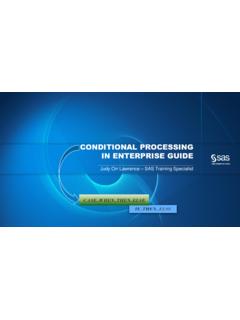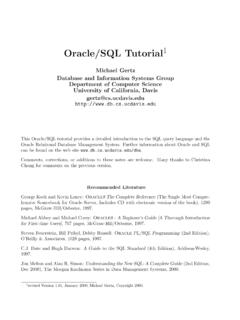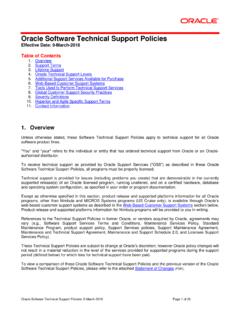Transcription of Proc SQL, the Data Step Killer
1 ProcSQL, the Data Step KillerMike AtkinsonAcko Systems Consulting IncData StepProcSQLThe Data Step It s a complete programming language Easy to combine (or merge) datasets It allows you to perform sequential algorithm steps Some algorithms require data to be in sorted order first Can use values of variables from different observations, using retain It has the where statement (stolen from SQL) that allows efficient use of filtering criteria prior to other processing There are some things the data step can do that can t be done in ProcSQL, Can create multiple datasets in one step Can easily join multiple datasets each left, right, or full outer join in a ProcSQL query can join only two datasets at a time (although inner joins without the join keyword can bring together any number)ProcSQL SQL is the de facto standard query language, widely used (beyond SAS even!)
2 For retrieving and summarizing data ProcSQL can summarize results in the same step as performing row level calculations without ProcSQL, summarizing requires a separate procsummary step, and often a pre-sort ProcSQL can sort its results in the same step It can perform distinct counts It can use like expressions While SQL isn t a complete programming language, it has case expressions, which can be very powerfulSome stuff SAS ProcSQL can do Sending (pass-through) queries to oracle (or another DBMS) for processing, and receiving the results into a SAS dataset Administration tasks, such as managing SAS datasets and indexes Using the SQL language against SAS datasets as an alternative to the Data Step Setting values of macro variables As an alternative to ProcPrintData stepBasic syntax:data new_SAS_dataset;set some_existing_dataset;/* set some_existing_dataset(keep=column_1 column_2); to subset variables*/* do stuff;run;ProcSQL Create TableBasic syntax:procsql;create table new_SAS_datasetas/* select * for all columns/variables*/select column_1,column_2from some_existing_dataset;quit.
3 Although it says create table, it is actually creating a SAS dataset. PROC SQL terminates with a quit;statement (not run;).WHERE clauseCan be used in data step statement and within ProcSQL, including within a case expressionComparison operators<, >, =, <=, >=, ^=or lt, gt, eq, le, ge, neLogic operators, bracketsand, or, ((a > b) and (not (c = d)))IN operatorin (values, separated, by, commas)WHERE clause like & contains While the in (list) has made its way to the IF statement, like (and contains ) have not; they are only in the WHEREThe syntax for CONTAINS is straightforward, name contains 'JONES'But I prefer LIKE, which is more powerfulpercent sign (%) match zero or more charactersunderscore (_)
4 Match any one where name like 'JONES%'ORDER BY clauseNot only does PROC SQL notrequire data to be sorted beforehand, but you can ask it to sort its resulting output simply by adding an ORDER BY clauseThe ORDER BY clause appears last, after the GROUP BY clause and the HAVING clause, if those are presentThe ORDER BY clause can be used on his own, without groupingThe syntax of the ORDER BY clause is slightly different than the Data Step (and other Procs ) BY statements; the BY statement separates variables by spaces, while the ORDER BY separates them using BY clauseThe GROUP BY clause in ProcSQL lets you summarisedata (similar to ProcSummary) but without requiring the data to be sorted GROUP BY clause (if present) follows the WHERE clauseVariables in the GROUP BY are separated by commasUsing a GROUP BY statement does not guarantee the sort order of the results (although SAS is more likely to put the data into that order than oracle is).
5 Use an ORDER BY with a GROUP BY if you need to ensure the sort order of the : the variables in the ORDER BY clause need not match the variables in the GROUP BY functionsIf you have a GROUP BY in your query, then every variable you select should either be listed in the GROUP BY, or be summarised in some way. If you select a variable that is not summarised and not listed in the GROUP BY clause, you will almost certainly not get the summarized results you are some sample summary functions:sum(services) as services,max(service_date) as max_servdt,mean(paid_amount) as avg_paidamt,count(distinct PHN) as patient_countHAVING ClausThe HAVING clause applies after the GROUP BY, WHERE asthe WHERE clause applies before groupingThe HAVING clause looks at summarisedvalues, and cannot be used without a GROUP BY ;create table three_or_moreasselect service_date,count(*) as record_countgroup by service_datehaving count(*) >= 3.
6 Quit;CASE expressionThis is PROC SQL s closest equivalent to the IF statement. A CASE expression, however, can only return a single value. (an IF statement can use a do/end to to perform multiple actions)The CASE expression consists of a series of WHEN conditions (that use the same syntax as WHERE conditions ), followed by ELSE. So it s really more like an IF WHEN condition is accompanied by a THEN expression that evaluates to a CASE expression will use the THEN expression of the first WHEN condition that is found to be True. If none of the WHEN conditions are true, the ELSE expression will be s good practice to always have an expression exampleprocsql;select case when age = 0 then ' 0 'when age between 1 and 5 then ' 1-5'when age between 6 and 10 then ' 6-10'when age between 11 and 15 then '11-15'.
7 Else '?????' end as age_group,count(distinct recipient_id) as person_cntfrom health_servicesgroup by calculated age_group;quit;AliasesWhen joining two or more tables, it is useful to use an alias for each alias can be used as a prefix to variable names to indicate which table the variable comes from, which is handier than using the whole table name as a a variable of the same name appears in more than one table (being joined using a ProcSQL select statement), you must specify which table you want to refer to each time you refer to the variable name. Prefixing variables with the table alias is the usual way to do JOIN, RIGHT JOINThe default SQL join is an Inner Join, meaning that only rows that match across both tables are includedLEFT JOIN and RIGHT JOIN in ProcSQL always operate on exactly two tables, and the order the tables are listed is very significant.
8 Imagine writing them on the same line the first dataset listed is the Left one, and the second is the Right you use LEFT JOIN or RIGHT JOIN, you use the ON keyword (instead of the WHERE keyword) to indicate the join you use the INNER JOIN syntax to perform an inner join, you will also need to use the ON keywordComparing Inner, Left, and Right joinsHere s some sample data in two , Jane56 Adams, Giselle78 Keppel, LenStudentsGradesStudent_IDSubjectGrade3 4 MathA34 EnglishB56 MathC+99 FrenchFInner Join (usual, without JOIN keyword)procsql;create table after_innerasselect a.*,b.*from students a,grades bwhere by ;quit;Note: This will give a note in the log that student_idalready exists in the dataset.
9 Because student_idis the same in both datasets (guaranteed by the WHERE condition), this note can be safely , here s how you could rid of the note(without listing all the columns you want)procsql;create table after_inner(drop=student_id2)asselect a.*,b.*from students a,grades (rename=(student_id=student_id2))bwhere by ;quit;It s probably easier just to ignore the note in the of (default) Inner JoinStudent_IDName34 Gray, Jane56 Adams, Giselle78 Keppel, LenStudentsGradesStudent_IDSubjectGrade3 4 MathA34 EnglishB56 MathC+99 FrenchFStudent_IDNameSubjectGrade34 Gray, JaneMathA34 Gray, JaneEnglishB56 Adams, GiselleMathC+After_InnerDefaultInner Joinon student_idLEFT Joinprocsql;create table after_leftasselect a.
10 *,b.*from students a left joingrades bon by ;quit;Results of Left JoinStudent_IDName34 Gray, Jane56 Adams, Giselle78 Keppel, LenStudentsGradesStudent_IDSubjectGrade3 4 MathA34 EnglishB56 MathC+99 FrenchFAfter_LeftLeft Joinon student_idStudent_IDNameSubjectGrade34 Gray, JaneMathA34 Gray, JaneEnglishB56 Adams, GiselleMathC+78 Keppel, LenRIGHT joinprocsql;create table after_rightasselect a.*,b.*from students a right joingrades bon by ;quit;Results of Right JoinStudent_IDName34 Gray, Jane56 Adams, Giselle78 Keppel, LenStudentsGradesStudent_IDSubjectGrade3 4 MathA34 EnglishB56 MathC+99 FrenchFAfter_RightRight Joinon student_idStudent_IDNameSubjectGrade34 Gray, JaneMathA34 Gray, JaneEnglishB56 Adams, GiselleMathC+FrenchFFULL (Outer) joinprocsql;create table after_fullasselect coalesce( , ) asstudent_id, , , students a full joingrades bon by ;quit.












